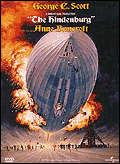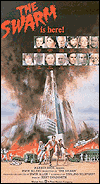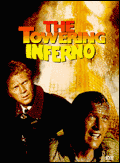Lights! Camera! Disaster!

The greatest disaster films of all time
by Beth Rowen |
 Related Links |
The disaster movie genre flourished in the 1970s, long before effects became major characters. While most of the early, campy films featured formulaic plots and one-dimensional characters, a few, such as Irwin Allen's Towering Inferno and Poseidon Adventure, remain classics. Here's a look of some of the Hollywood's legendary disaster films.
The Abyss (1985)
Another over-budget ocean saga by self-proclaimed "King of the World" James Cameron. This director's cut is worth a view on video as it fills plot gaps that didn't make the theatrical release. In the film, an oil-rig crew and the Navy SEALs join forces to rescue a nuclear sub that has sunk 25,000 feet. The team unexpectedly runs into a species of aquatic aliens. The film won an Oscar for visual effects.
Airport (1970)
One of the first disaster films of the era, Airport spawned three sequels and scores of imitations, both laughable and laudable. Though personal drama often takes a secondary role to the catastrophe at hand, Airport's many scandalous liaisons are as prominent as the bomb aboard the Boeing 707. But the bomb's just one of the looming disasters that plague a Manhattan airport during the film's blizzard. Helen Hayes won a Best Supporting Actress Oscar for her role as a stowaway.
Earthquake (1974)
Put this one down as a guilty pleasure. The big draw to theaters in was the debut of Sensurround, technology that promised viewers would "feel" the earthquake that destroyed Los Angeles. Well, Sensurround didn't really deliver. But the arch performances of Charlton Heston, Ava Gardner, Genevieve Bujold, and Richard Roundtree caused quite a rumbling.
The Hindenburg (1975)

This Hollywood-ization of the 1937 disaster imagines that a bomb was planted on the zeppelin. While The Hindenburg fictionalized the tragedy, it remained scrupulously faithful to detail, from the murals on the walls to the portrayal of the vessel's demise. Newsreel footage was combined with special effects, creating an eerily realistic explosion. The film won two special Oscars for visual and sound effects.
A Night to Remember (1958)
While this film is no match technically for the 1997 Titanic film, A Night to Remember beats the blockbuster in almost every other category. Director Roy Ward Baker took a documentary approach to chronicling the disaster on film, examining how and why the unsinkable sank. His fully realized characters sprang to life, eliciting sympathy and compassion.
Outbreak (1995)
The release of Wolfgang Peterson's epidemic film coincided with the country's obsession with the Ebola virus described in Richard Preston's bestselling The Hot Zone. A killer virus identified in the 1960s has resurfaced in Africa and wiped out an entire African village. Decades later, an infected monkey is smuggled into the U.S. and threatens the human population. Dustin Hoffman's disease expert teams up with his ex-wife (Rene Russo) to find an antidote.
The Poseidon Adventure (1972)
The disaster film that virtually defined the genre, The Poseidon Adventure boasted all the elements of a Hollywood blockbuster: a bloated budget, arch dialogue, and an all-star cast. Only 10 passengers survive when a tidal wave capsizes a luxury liner on New Year's Eve. The lucky ones, led by Gene Hackman's minister, struggle to navigate their way to the top (actually the bottom) of the ship. The film was nominated for eight Oscars, and won for Best Song. It also received an honarary award for visual effects.
Runaway Train (1985)
Akira Kurosawa wrote the screenplay for this overlooked film starring Eric Roberts, Jon Voight, and Rebecca DeMornay. In fact, Kurosawa was slated to direct the film in the 1970s, but the project never got off the ground. Voight and Roberts play inmates who've escape from an Alaskan maximum-security prison and hop a moving train. When they learn the train's a runaway and on a collision course with an oncoming train, the criminals take matters into their own hands.
San Francisco (1936)
This gem of classic Hollywood featured some of the most impressive effects of the era. Spencer Tracy, Clark Gable, Jeanette MacDonald, and Jack Holt star in this love story-disaster epic set in 1906 on the Barbary Coast. Bordello owner Gable and impresario Holt compete for the affection of MacDonald's performer. Tragedy strikes when the Great Earthquake of 1906 devastates the city.
The Swarm (1978)

After successfully producing and directing 1974's Towering Inferno, "Master of Disaster" Irwin Allen took on the dual role once again in this outing about a swarm of killer bees that migrate from South America and threaten to infest Houston. Michael Caine's entomologist teams up with a heavy-handed general (Richard Widmark) to thwart the deadly bugs. Critics gave the film stinging reviews, but it's camp at its best.
Titanic (1997)
It was the most-talked about film of the year, and the big winner at Oscar time (11 awards, including Best Picture, Director, and Cinematography). The spectacular film boasted enchanting performances from Leonardo DiCaprio and Kate Winslet as doomed star-crossed lovers, fabulous cinematography, captivating storytelling and, of course, an awe-inspiring ship (built 90 percent to scale). Director James Cameron used the love story between first-class formerly rich Rose (Winslet) and third-class bohemian artist Jack (DiCaprio) to distract us from the fact that Titanic was a purely technological extravaganza. After all, audiences that spent nearly $600,000,000 at the box office weren't waiting in line to see how the film ended.
Towering Inferno (1974)

This multiple Oscar winner (Cinematography, Editing, and Song) is still considered one of the best disaster movies of all time—quite an accomplishment considering the film was produced in the pre-computer-driven effects era. Paul Newman led the all-star cast of revelers celebrating the completion of the world's tallest building (138 floors). When a fire breaks out on an upper floor, Newman's architect and Steve McQueen's fire chief scramble to evacuate the guests.
Twister (1996)
As in most technology-driven films, plot and dialogue are secondary to effects, but who cares when cows fly and a tanker truck falls from the sky. Not only are university scientists Helen Hunt and Bill Paxton racing to the eye of the storm, they're also battling "corporate tornado chasers" who seek to profit by measuring the intensity of tornadoes.
The Day After Tomorrow (2004)
While criticized by experts for being scientifically inaccurate and political propaganda, this film about the catastrophic consequences of global warming captured the public's imagination and was a box office success. A massive super storm creates huge sea swells that devastate part of the country and leaves behind an Arctic freeze in its wake. The characters, led by Jack (Denis Quaid) and his son Sam (Jake Gylenhall), desperately fight for survival as New York is gripped by the world's worst winter storm and the rest of the country evacuates to warmer climates.
War of the Worlds (2005)
This Steven Spielberg film based on H.G. Wells's classic novel stars Tom Cruise as Ray Ferrier, a divorced father who works the night shift at a New Jersey shipping dock. When extraterrestrials attack Earth in "tripods," which have shields that defend against military attack, Ray attempts to escape and lead his children to safety. While humans stand no chance of stopping the invaders, it is Mother Nature that takes up the fight to save humanity. The microorganisms that humans have grown immune to end up leading to the downfall of the invading force.
World Trade Center (2006)
The first movie to focus on the September 11th terrorist attacks on the World Trade Center, this Oliver Stone-directed film depicts the true story of Port Authority police officers John McLoughlin (Nicolas Cage) and Will Jimeno (Michael Peña), who were two of only 20 survivors to be rescued from the wreckage of the towers after they fell. The pair directs evacuation efforts in the lobby of the south tower until it begins to collapse and they are forced to rush to the nearest escalator shaft for cover. The film was generally praised by critics for remaining faithful to the actual events and for highlighting the human element of the disaster rather than making a political statement.
Cloverfield (2008)
With nauseating, shaky cinematography and scenes scary enough to elicit screams, 2008 disaster film is the story of a group of 20–somethings who are videotaping a going–away party when a giant shadow–clad creature descends upon New York City, leaving the metropolis in the dark and without power. When power is restored, the friends confront a world turned upside down by the creature's devastating acts of destruction, such as the decapitation of the Statue of Liberty. As their city becomes a war zone, the friends fight to survive in the midst of a seemingly unconquerable assailant and the military sent to destroy it.







